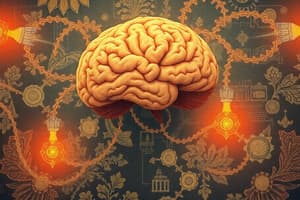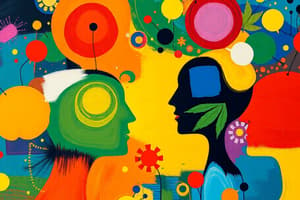Podcast
Questions and Answers
Chimpanzees are not capable of learning a do-as-I-do game according to Custance et al. (1995).
Chimpanzees are not capable of learning a do-as-I-do game according to Custance et al. (1995).
False (B)
Stimulus enhancement involves copying an action without understanding the goal of the action.
Stimulus enhancement involves copying an action without understanding the goal of the action.
False (B)
Imitation in non-human primates is not controversial and widely accepted among researchers.
Imitation in non-human primates is not controversial and widely accepted among researchers.
False (B)
Cumulative culture is abundant in non-human primates like chimpanzees.
Cumulative culture is abundant in non-human primates like chimpanzees.
Imitation by human infants is solely based on stimulus or location enhancement.
Imitation by human infants is solely based on stimulus or location enhancement.
Imitation is more prevalent in the wild than in labs.
Imitation is more prevalent in the wild than in labs.
Imitation in humans serves a social function, while imitation in chimps is mainly used to obtain personal rewards like food.
Imitation in humans serves a social function, while imitation in chimps is mainly used to obtain personal rewards like food.
Reading and number recognition recruit different neural resources in brains across different cultures.
Reading and number recognition recruit different neural resources in brains across different cultures.
Different cultural systems for representing numbers have no impact on cognitive performance.
Different cultural systems for representing numbers have no impact on cognitive performance.
Mirror neurons only respond to self-executed actions, not observed actions.
Mirror neurons only respond to self-executed actions, not observed actions.
The main evolutionary pressure for human intellectual development is the ability to be smarter.
The main evolutionary pressure for human intellectual development is the ability to be smarter.
Modern human culture, like city dwelling, has been around long enough to have evolved.
Modern human culture, like city dwelling, has been around long enough to have evolved.
The ability to read complex social cues is a primary function of the Superior Temporal Sulcus (STS).
The ability to read complex social cues is a primary function of the Superior Temporal Sulcus (STS).
Non-human species do not exhibit any degree of social intelligence comparable to humans.
Non-human species do not exhibit any degree of social intelligence comparable to humans.
Neocortex ratio is one of the changes driven by the pressure to be socially smarter in humans.
Neocortex ratio is one of the changes driven by the pressure to be socially smarter in humans.
Nonhuman primates do not have mirror neurons related to tool use.
Nonhuman primates do not have mirror neurons related to tool use.
Cumulative culture is believed to be present in most species, including humans and chimpanzees.
Cumulative culture is believed to be present in most species, including humans and chimpanzees.
Imitation is a controversial concept in primates, including humans.
Imitation is a controversial concept in primates, including humans.
The unique aspect of complex culture in humans is solely attributed to the presence of mirror neurons.
The unique aspect of complex culture in humans is solely attributed to the presence of mirror neurons.
Tool use is facilitated by multisensory neurons that can be found in both human and nonhuman primates.
Tool use is facilitated by multisensory neurons that can be found in both human and nonhuman primates.
Monkeys, chimpanzees, and humans all possess mirror neurons based on the text.
Monkeys, chimpanzees, and humans all possess mirror neurons based on the text.
Macaque monkeys can imitate tool use after a single exposure, like humans, according to the text.
Macaque monkeys can imitate tool use after a single exposure, like humans, according to the text.
The ability for macaques to imitate tongue protrusion is considered contagion rather than imitation in the text.
The ability for macaques to imitate tongue protrusion is considered contagion rather than imitation in the text.
There is more to imitation and tool use than mirror neurons according to the text.
There is more to imitation and tool use than mirror neurons according to the text.
Examine what is different in the brains of macaques that have mastered tool use relative to novices is suggested as a potential solution across species according to the text.
Examine what is different in the brains of macaques that have mastered tool use relative to novices is suggested as a potential solution across species according to the text.
The genetic selection of serotonin transporter and cultural selection of collectivism/individualism co-evolved according to Chiao et al.
The genetic selection of serotonin transporter and cultural selection of collectivism/individualism co-evolved according to Chiao et al.
The vmPFC stands for ventral mesial Prefrontal Cortex.
The vmPFC stands for ventral mesial Prefrontal Cortex.
Facial emotion processing primarily occurs in the hippocampus.
Facial emotion processing primarily occurs in the hippocampus.
Non-Human Cultures and Traditions are limited to mammals only.
Non-Human Cultures and Traditions are limited to mammals only.
Social learning in non-human primates can involve mechanisms like imitation, stimulus enhancement, and contagion.
Social learning in non-human primates can involve mechanisms like imitation, stimulus enhancement, and contagion.
Primates' ability to survive and reproduce depends on their capacity to manipulate others within kinship and dominance relations.
Primates' ability to survive and reproduce depends on their capacity to manipulate others within kinship and dominance relations.
According to Dunbar (1992), there is a correlation between whole brain size and the size of social groups in primates.
According to Dunbar (1992), there is a correlation between whole brain size and the size of social groups in primates.
Byrne & Corp (2004) found a correlation between brain size and the frequency of contagious yawning in primates.
Byrne & Corp (2004) found a correlation between brain size and the frequency of contagious yawning in primates.
Joffe (1997) concluded that brain size is linked to the duration of immaturity in primates.
Joffe (1997) concluded that brain size is linked to the duration of immaturity in primates.
Reading complex social cues is associated with the ventromedial prefrontal cortex (vmPFC).
Reading complex social cues is associated with the ventromedial prefrontal cortex (vmPFC).
Genetic selection of dopamine transporter plays a significant role in cultural selection in primates.
Genetic selection of dopamine transporter plays a significant role in cultural selection in primates.
Non-human cultures and traditions do not contribute to the social learning abilities of primates.
Non-human cultures and traditions do not contribute to the social learning abilities of primates.
Imitation is a controversial social learning mechanism widely debated among researchers studying non-human primates.
Imitation is a controversial social learning mechanism widely debated among researchers studying non-human primates.
Stimulus enhancement involves understanding the goal of an observed action rather than just copying it.
Stimulus enhancement involves understanding the goal of an observed action rather than just copying it.
Contagion is a mechanism of social learning based on replicating behaviors observed in others.
Contagion is a mechanism of social learning based on replicating behaviors observed in others.
Tool use is solely facilitated by the presence of mirror neurons in non-human primates.
Tool use is solely facilitated by the presence of mirror neurons in non-human primates.
Cultural selection of collectivism/individualism has no connection with genetic selection of serotonin transporter.
Cultural selection of collectivism/individualism has no connection with genetic selection of serotonin transporter.
The unique aspect of complex culture in humans is primarily attributed to the presence of mirror neurons.
The unique aspect of complex culture in humans is primarily attributed to the presence of mirror neurons.
Imitation in non-human primates is widely accepted and uncontroversial among researchers.
Imitation in non-human primates is widely accepted and uncontroversial among researchers.
Reading and number recognition in different cultures recruit the same neural resources in the brain.
Reading and number recognition in different cultures recruit the same neural resources in the brain.
Monkeys, chimpanzees, and humans all possess mirror neurons.
Monkeys, chimpanzees, and humans all possess mirror neurons.
Cross-cultural differences in individualism and collectivism have no impact on cognitive performance.
Cross-cultural differences in individualism and collectivism have no impact on cognitive performance.
Stimulus enhancement involves copying an action without understanding the goal of the action.
Stimulus enhancement involves copying an action without understanding the goal of the action.
Reading complex social cues is primarily associated with the ventromedial prefrontal cortex (vmPFC).
Reading complex social cues is primarily associated with the ventromedial prefrontal cortex (vmPFC).
Different cultural systems for representing numbers have a significant impact on cognitive performance.
Different cultural systems for representing numbers have a significant impact on cognitive performance.
Reward responses in the striatum are primarily driven by imitation behaviors in both humans and chimpanzees.
Reward responses in the striatum are primarily driven by imitation behaviors in both humans and chimpanzees.
Genetic selection of serotonin transporter does not play a significant role in cultural selection in primates.
Genetic selection of serotonin transporter does not play a significant role in cultural selection in primates.
Cross-cultural differences in individualism/collectivism have no impact on social learning abilities of primates.
Cross-cultural differences in individualism/collectivism have no impact on social learning abilities of primates.
Self-representation in the vmPFC is a key aspect of imitation behaviors in non-human primates.
Self-representation in the vmPFC is a key aspect of imitation behaviors in non-human primates.
Imitation, stimulus enhancement, and contagion are all mechanisms of social learning observed in non-human primates.
Imitation, stimulus enhancement, and contagion are all mechanisms of social learning observed in non-human primates.
Chimps, but not macaques, are capable of learning a do-as-I-do game according to Custance et al. (1995).
Chimps, but not macaques, are capable of learning a do-as-I-do game according to Custance et al. (1995).
Potato washing and using sticks to get food in non-human primates arises from true imitation.
Potato washing and using sticks to get food in non-human primates arises from true imitation.
Imitation in non-human primates mainly involves copying actions without understanding the goals of those actions.
Imitation in non-human primates mainly involves copying actions without understanding the goals of those actions.
Stimulus enhancement is a mechanism of social learning where behaviors that are innate rather than learned are repeated.
Stimulus enhancement is a mechanism of social learning where behaviors that are innate rather than learned are repeated.
Imitation by human infants is solely based on stimulus or location enhancement.
Imitation by human infants is solely based on stimulus or location enhancement.
Macaque monkeys can imitate tool use after a single exposure, like humans, according to the text.
Macaque monkeys can imitate tool use after a single exposure, like humans, according to the text.
The genetic selection of serotonin transporter and the cultural selection of collectivism/individualism co-evolved according to Chiao et al.
The genetic selection of serotonin transporter and the cultural selection of collectivism/individualism co-evolved according to Chiao et al.
The unique aspect of complex culture in humans is solely attributed to the presence of mirror neurons.
The unique aspect of complex culture in humans is solely attributed to the presence of mirror neurons.
Imitation in humans serves a social function, while imitation in chimps is mainly used to obtain personal rewards like food.
Imitation in humans serves a social function, while imitation in chimps is mainly used to obtain personal rewards like food.
Stimulus enhancement involves understanding the goal of an observed action rather than just copying it.
Stimulus enhancement involves understanding the goal of an observed action rather than just copying it.
Reading and number recognition recruit different neural resources in brains across different cultures.
Reading and number recognition recruit different neural resources in brains across different cultures.
The genetic selection of serotonin transporter and cultural selection of collectivism/individualism co-evolved according to Chiao et al.
The genetic selection of serotonin transporter and cultural selection of collectivism/individualism co-evolved according to Chiao et al.
Monkeys, chimpanzees, and humans all possess mirror neurons based on the text.
Monkeys, chimpanzees, and humans all possess mirror neurons based on the text.
Imitation by human infants is solely based on stimulus or location enhancement.
Imitation by human infants is solely based on stimulus or location enhancement.
Facial emotion processing primarily occurs in the hippocampus.
Facial emotion processing primarily occurs in the hippocampus.
Social learning in non-human primates can involve mechanisms like imitation, stimulus enhancement, and contagion.
Social learning in non-human primates can involve mechanisms like imitation, stimulus enhancement, and contagion.
Mirror neurons only respond to self-executed actions, not observed actions.
Mirror neurons only respond to self-executed actions, not observed actions.
The main evolutionary pressure for human intellectual development is the ability to be smarter.
The main evolutionary pressure for human intellectual development is the ability to be smarter.
Reading complex social cues is associated with the ventromedial prefrontal cortex (vmPFC).
Reading complex social cues is associated with the ventromedial prefrontal cortex (vmPFC).
Monkeys, chimpanzees, and humans all possess mirror neurons.
Monkeys, chimpanzees, and humans all possess mirror neurons.
Cross-cultural differences in individualism and collectivism do not influence reward responses in the striatum.
Cross-cultural differences in individualism and collectivism do not influence reward responses in the striatum.
Genetic selection of dopamine transporter is a key factor in cultural selection of individualism/collectivism according to the text.
Genetic selection of dopamine transporter is a key factor in cultural selection of individualism/collectivism according to the text.
Self-representation in the vmPFC is not related to differences in visual and attentional processing.
Self-representation in the vmPFC is not related to differences in visual and attentional processing.
Imitation, stimulus enhancement, and contagion are common mechanisms of social learning observed in both humans and non-human primates according to the text.
Imitation, stimulus enhancement, and contagion are common mechanisms of social learning observed in both humans and non-human primates according to the text.
Cultural selection of collectivism/individualism co-evolved with genetic selection of the dopamine transporter.
Cultural selection of collectivism/individualism co-evolved with genetic selection of the dopamine transporter.
What did Stolier & Freeman find regarding brain activity patterns in the fusiform gyrus when participants showed greater mouse-tracking attraction toward the non-chosen category?
What did Stolier & Freeman find regarding brain activity patterns in the fusiform gyrus when participants showed greater mouse-tracking attraction toward the non-chosen category?
How do stereotypes affect visual perception according to Stolier & Freeman (2016)?
How do stereotypes affect visual perception according to Stolier & Freeman (2016)?
In the context of weapon identification tasks, what finding aligns with the text?
In the context of weapon identification tasks, what finding aligns with the text?
What prediction was confirmed by Stolier & Freeman regarding neural representations in the brain?
What prediction was confirmed by Stolier & Freeman regarding neural representations in the brain?
Which statement aligns with the text's findings about visual processing efficiency?
Which statement aligns with the text's findings about visual processing efficiency?
How does the text describe the categorization of Black and Asian faces in terms of gender?
How does the text describe the categorization of Black and Asian faces in terms of gender?
Which brain region is primarily involved in coding facial identity?
Which brain region is primarily involved in coding facial identity?
According to the Haxby model, which of the following is NOT part of the 'core system' for face processing?
According to the Haxby model, which of the following is NOT part of the 'core system' for face processing?
Which brain region is involved in processing actions related to faces and bodies?
Which brain region is involved in processing actions related to faces and bodies?
Which of the following statements about the fusiform face area (FFA) is NOT true?
Which of the following statements about the fusiform face area (FFA) is NOT true?
Which of the following statements about the occipital face area (OFA) is true?
Which of the following statements about the occipital face area (OFA) is true?
Based on the information provided, which of the following statements is true?
Based on the information provided, which of the following statements is true?
Which of the following statements about mirror neurons is correct?
Which of the following statements about mirror neurons is correct?
What is a potential explanation for the differences in spontaneous tool use and imitation abilities across different primate species?
What is a potential explanation for the differences in spontaneous tool use and imitation abilities across different primate species?
Which of the following statements about the relationship between reading and numeric recognition across cultures is correct?
Which of the following statements about the relationship between reading and numeric recognition across cultures is correct?
What is the proposed mechanism by which tool use can lead to changes in the brain's representation of the body?
What is the proposed mechanism by which tool use can lead to changes in the brain's representation of the body?
Which of the following statements about social learning mechanisms in primates is correct?
Which of the following statements about social learning mechanisms in primates is correct?
Which of the following statements about the relationship between cultural factors and genetic factors in primates is correct?
Which of the following statements about the relationship between cultural factors and genetic factors in primates is correct?
Flashcards are hidden until you start studying




